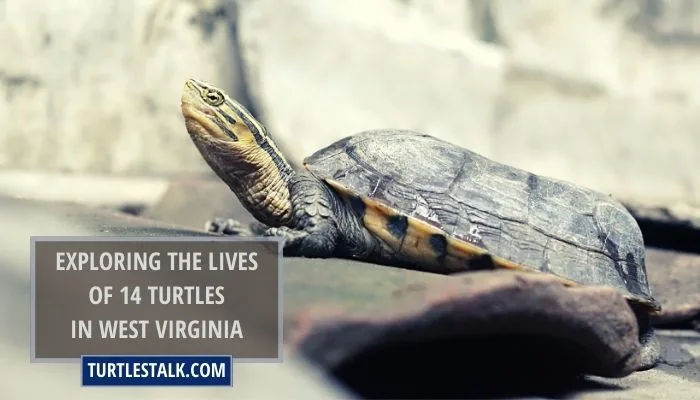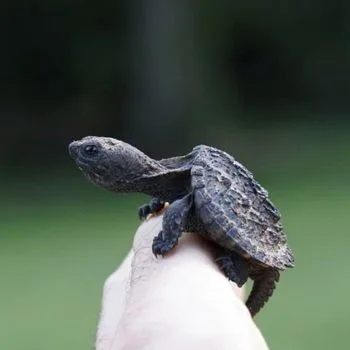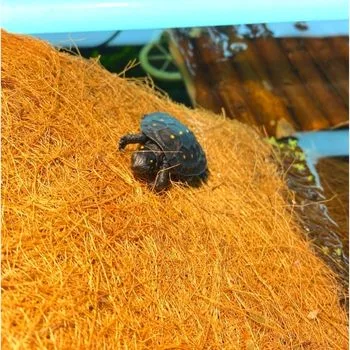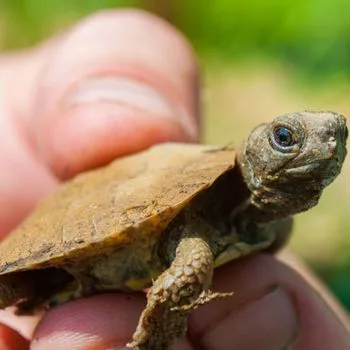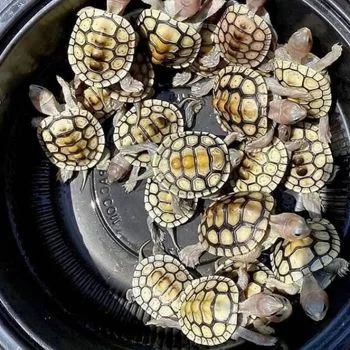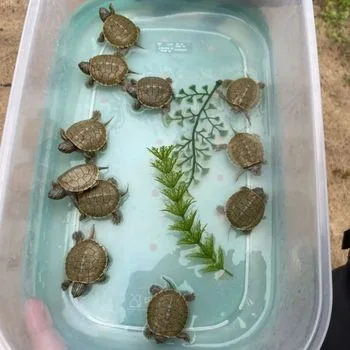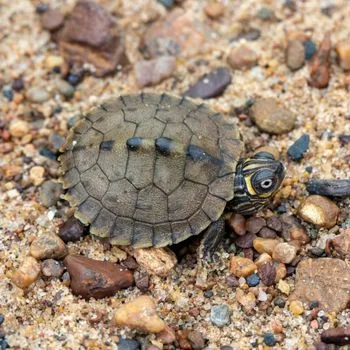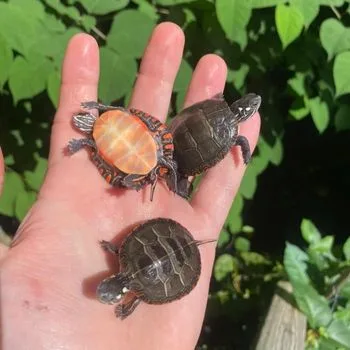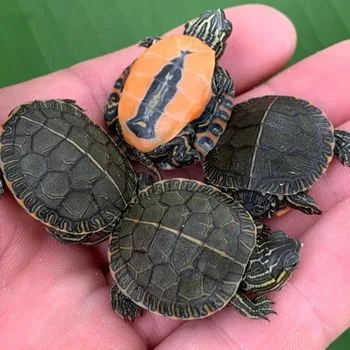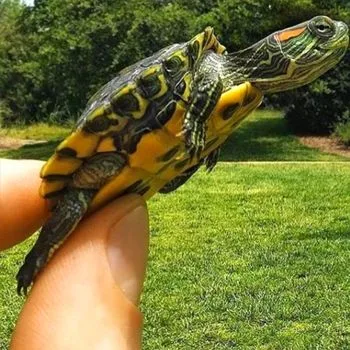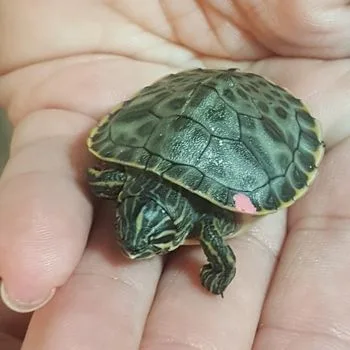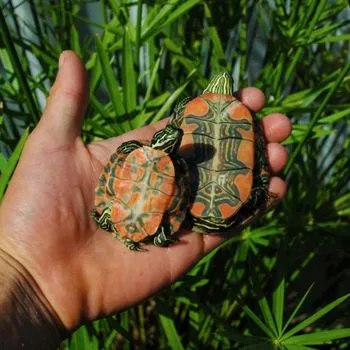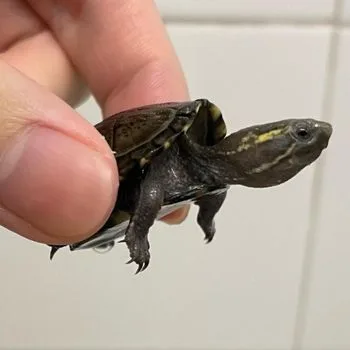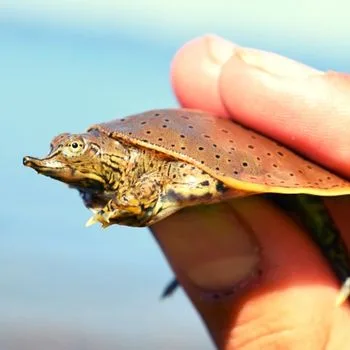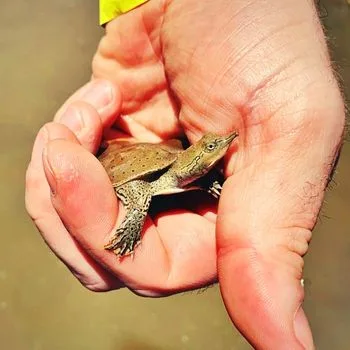Exploring the Lives of 14 Turtles in West Virginia
West Virginia is a beautiful state, and it’s home to some amazing creatures. From the majestic bald eagle to the mysterious spotted turtle, this state is teeming with wildlife that will amaze you! But what kind of turtles live in West Virginia?
Well, we’ve got 14 species, including common snapping turtle, spotted turtle, wood turtle, eastern box turtle, etc.
So if you’re looking for an exciting way to explore nature in West Virginia, start by learning about all these incredible turtles!
| # | Name | Details | Image |
| 1 | Common Snapping Turtle (Chelydra serpentina) |
| 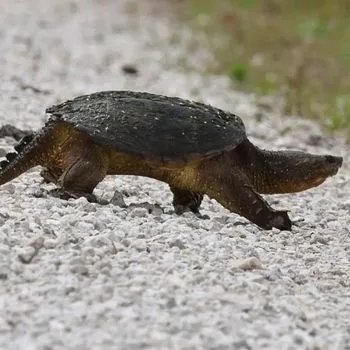 |
| 2 | Spotted Turtle (Clemmys Guttata) |
| 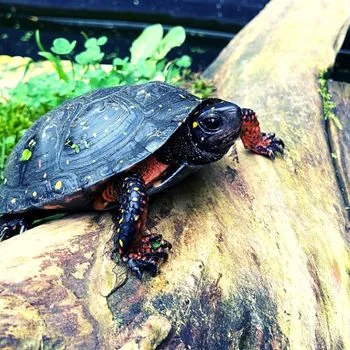 |
| 3 | Wood Turtle (Glyptemys Insculpta) |
| 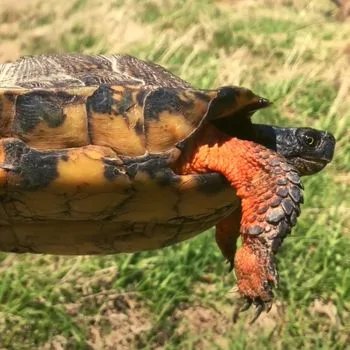 |
| 4 | Eastern Box Turtle (Terrapene Carolina) |
| 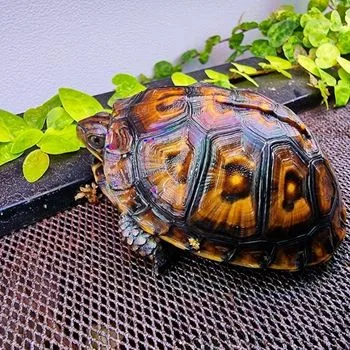 |
| 5 | Northern Map Turtle (Graptemys Geographica) |
| 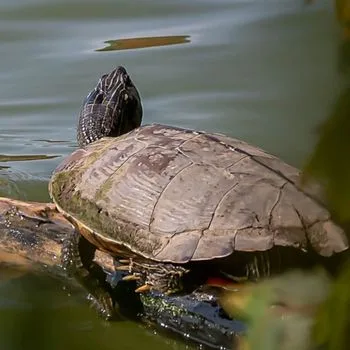 |
| 6 | Ouachita Map Turtle (Graptemys Ouachitensis) |
| 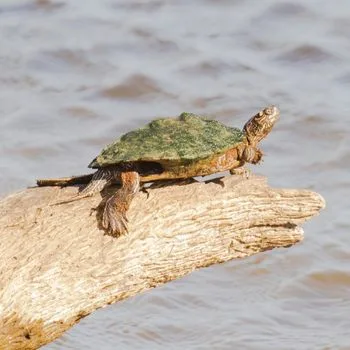 |
| 7 | Eastern Painted Turtle (Chrysemys Picta) |
| 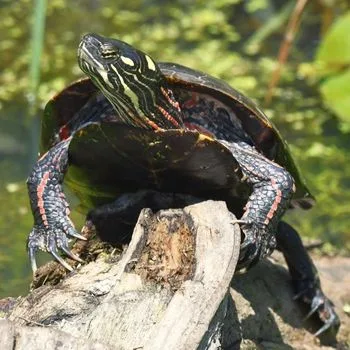 |
| 8 | Midland Painted Turtle (Chrysemys Picta Marginata) |
|  |
| 9 | Red Eared Slider (Trachemys Scripta Elegans) |
| 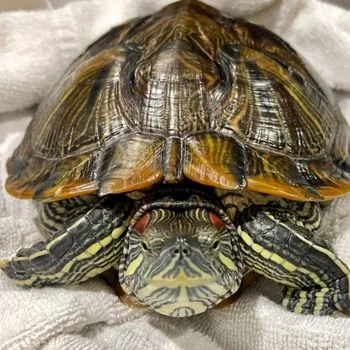 |
| 10 | Eastern River Cooter (Pseudemys Concinna) |
| 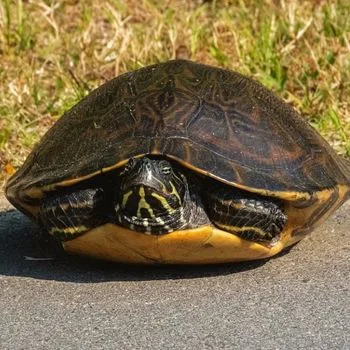 |
| 11 | Northern Red-Bellied Cooter (Pseudemys Rubriventris) |
| 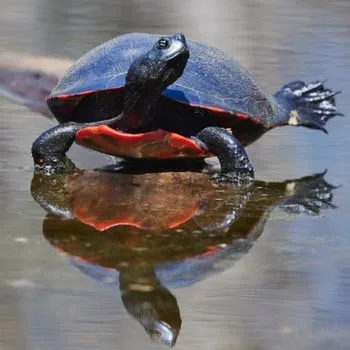 |
| 12 | Common Musk Turtle (Sternotherus Odoratus) |
| 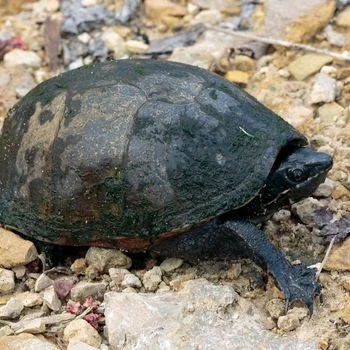 |
| 13 | Northern Spiny Softshell Turtle (Apalone Spinifera Hartwegi) |
| 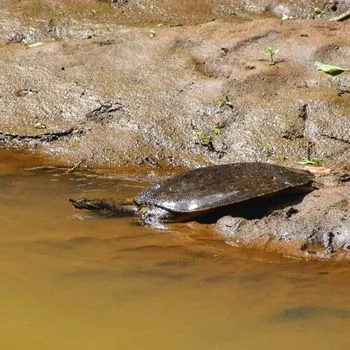 |
| 14 | Smooth Softshell Turtle (Apalone Mutica) |
| 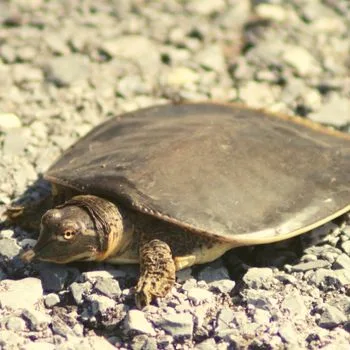 |
14 Turtles You Can Find in West Virginia
In total, there are 14 species of turtles in the state of West Virginia. This guide will take you on an exploration through each turtle type and provide tips for providing them with proper care. So, let’s get started on our journey into discovering all the wonders that these reptiles have to offer!
1. Common Snapping Turtle (Chelydra serpentina)
- Family: Chelydridae
- Genus: Chelydra
- Type: Freshwater turtle
- Natural Habitat: Freshwater habitats such as lakes, rivers, and swamps
- Lifespan: 50 years
- Maximum Size: 19 inches
- Maximum Weight: 40 pounds
- Prone to Diseases: Fungal infections and shell rot
- Aggression Level: Not aggressive until provoked
- Predators: River otters, bears and coyotes
- Domestication: Not recommended as pets
The Common Snapping Turtle, scientifically known as Chelydra serpentina, is an aquatic species native to freshwater habitats such as lakes, rivers and swamps. These turtles are highly adaptable and can live up to 50 years in the wild.
Adult Common Snapping Turtles typically measure 10-16 inches in shell length but can grow up to 19 inches and weigh around 40 pounds. They have a powerful bite with an estimated pressure of over 600 psi, making them one of the strongest biters among reptiles. Despite their strength they are generally not aggressive animals, though it is best to not provoke them and take caution around them.
Common Snapping Turtles often face threats from predators such as river otters, bears and coyotes when living out in the wild.
Unfortunately, their habitat is also threatened by human activities such as development and pollution which can lead to a decrease in population numbers if conservation efforts are not taken soon here in West Virginia.
Although they make fascinating pets due to their long lifespan of up to 50 years when cared for properly, some states have regulations or restrictions on owning them so check with local authorities before acquiring this species as a pet.
These turtles have webbed feet for swimming and a long tail for propulsion allowing them to move quickly through water which also makes them difficult prey for predators.
Furthermore, although they occupy multiple states across North America from Alabama to Wyoming there is no other name than the Common Snapping Turtle so it’s easy to identify.
It should be noted that this species does not carry any significant disease that can be transmitted to humans yet they may still be prone to diseases like fungal infections or shell rot when kept in unsanitary conditions so proper care must be taken here in West Virginia when considering owning one of these remarkable creatures as a pet.
2. Spotted Turtle (Clemmys Guttata)
- Family: Emydinae rafinesque
- Genus: Clemmys
- Type: Semi-aquatic turtle
- Natural Habitat: Marshy meadows, ponds, ditches, bogs, swamps, etc. as small bodies of still water.
- Lifespan: 60 – 100+ years
- Maximum Size: 4 – 5 inches
- Maximum Weight: 0.5 to 1 pound
- Prone to Diseases: Vitamin a deficiency, respiratory diseases, abscesses, shell infections and fractures, and parasites
- Disease Carrier: Salmonella
- Aggression Level: Coexisting is possible for spotted turtles, but housing male individuals together may lead to aggression.
- Predators: Mammals, such as raccoons, muskrats, birds and large fishes.
- Domestication: Can be kept as pets
Introducing the Spotted Turtle (Clemmys Guttata)! This small, terrestrial and aquatic turtle is native to the eastern United States from Maine down to West Virginia. Adults grow up to 4-5 inches in carapace length, with a weight ranging between half a pound and one pound. Juveniles can measure between 1-3 inches when they hatch.
These animals are quite hardy creatures who generally live peaceably amongst their own kind; however, under threat they may become somewhat aggressive. There are several predators that hunt them such as raccoons, skunks, snakes and birds of prey in this area.
Despite being only mildly domesticated creatures it is possible for these turtles to be kept as pets with specialized care. Prone illnesses include respiratory infections and shell rot – but fortunately this species does not act as a disease carrier itself!
3. Wood Turtle (Glyptemys Insculpta)
- Family: Emydidae
- Genus: Glyptemys
- Type: Semi-aquatic turtle
- Natural Habitat: They prefer to sleep in streams surrounded by forests during the winter but venture out to grasslands, barren areas, and sandy shores for food and nesting during the spring.
- Lifespan: 12+ years
- Maximum Size: 6 to 10 inches
- Maximum Weight: 0.5 – 2 pounds
- Prone to Diseases: Selenosis, metabolic disease
- Disease Carrier: Salmonella
- Aggression Level: Not aggressive
- Predators: Raccoons, coyotes, and foxes, arious mammals, fishes, and birds prey
- Domestication: Can be kept as pet if collected from a collector
The wood turtle (Glyptemys insculpta) is a semi-aquatic species of reptile native to Eastern North America, ranging from Nova Scotia to West Virginia. It is distinguishable by its dark coloring, with yellowish and orange markings across the shell that can even become brighter in the sun.
Typically measuring between 6 – 10 inches and weighing half a pound up to two pounds, the wood turtle that inhabits West Virginia is both an impressive sight and hardy survivor.
Found mainly near forests where it spends winters asleep in streams, these turtles often venture into grasslands or sandy shores for food during the spring months. Wood turtles aren’t typically aggressive but must still beware as raccoons, coyotes and foxes are among their predators. They even possess a powerful bite force that allows them to break through shells!
4. Eastern Box Turtle (Terrapene Carolina)
- Family: Emydidae
- Genus: Terrapene
- Type: Terrestrial turtle
- Natural Habitat: Deciduous and mixed forests, meadows, and fields
- Lifespan: 60 years
- Also Known As: Eastern terrapin
- Maximum Size: 4-10 inches
- Maximum Weight: Male: 1 pounds, females: 2 pounds
- Prone to Diseases: Respiratory infections, shell rot, and other diseases
- Aggression Level: Not aggressive towards humans
- Predators: Raccoons, skunks, opossums, and snakes
- Domestication: Can be kept as pets
The Eastern Box Turtle (Terrapene Carolina) is one of the most intriguing species found in deciduous and mixed forests, meadows, and fields of eastern North America. This incredible turtle can live up to 40 years in the wild or even reach up to 60 years in captivity! With adult sizes ranging from 4-10 inches, males being slightly smaller than females with a weight of 0.5-1 lb for males and 1-2 lbs for females.
Eastern Box Turtles are not too aggressive towards humans but potential predators may include raccoons, skunks, opossums, and snakes. They can be kept as pets but it is important to consult local laws before doing so since some states make it illegal to collect wild turtles or sell them as pets—including West Virginia. Captive Eastern Box Turtles may be prone to respiratory infections, shell rot, and other diseases common to captive turtles.
This species is state-protected in several states due to the declining population caused by habitat loss and illegal collection for the pet trade. Despite this precarious situation, Eastern Box Turtles can still be found in eastern North America—including West Virginia. It is essential that we take steps to protect this species which calls West Virginia home by preserving their natural habitats as well as improving public awareness of their plight!
5. Northern Map Turtle (Graptemys Geographica)
- Family: Emydidae
- Genus: Graptemys
- Type: Aquatic turtle
- Natural Habitat: Rivers, streams, and large ponds in the northern united states
- Lifespan: 20+ years
- Also Known As: Common map turtle
- Maximum Size: Males: can reach up to 6 inches, females: can reach up to 10 inches
- Maximum Weight: Males: 150-400 gm, females: 1.5-5.5 pounds
- Prone to Diseases: Contaminants due to the diet habit
- Aggression Level: Not aggressive
- Predators: Racoons, coyotes and skunks
- Domestication: Can be kept as pet
The Northern Map Turtle (Graptemys geographica) is a species of aquatic turtle native to the rivers, streams and large ponds in the northern United States. They can reach up to 10 inches in carapace length with male size being smaller than female. Adults don’t have many natural predators but juveniles are preyed upon by birds, mammals and larger fish.
These strong swimmers have an excellent carapace for protection from danger and they can live up to 20-25 years if properly cared for! Given their beautiful markings, it’s no surprise that these turtles are becoming increasingly popular as pets – just remember they must be treated with care and may require permits depending on the state, including West Virginia. They’re also prone to respiratory infections when kept in captivity so it’s important to monitor them closely.
Luckily, this majestic species isn’t endangered yet – though population numbers may be decreasing rapidly in certain areas. The Northern Map Turtles can are easily found living around Illinois, Indiana, Iowa, Michigan, Minnesota, Missouri, Ohio, and Wisconsin among other US states!
6. Ouachita Map Turtle (Graptemys Ouachitensis)
- Family: Emydidae
- Genus: Graptemys
- Type: Aquatic turtle
- Natural Habitat: Slow-moving freshwater rivers, streams, and lakes
- Lifespan: 30 – 50 years
- Also Known As: Sawback
- Maximum Size: Males: 3 to 6.5 inches, females: 4.0 to roughly 11 inches
- Maximum Weight: 1.5 – 4.5 pounds
- Prone to Diseases: Shell rot, respiratory infections
- Disease Carrier: Salmonella
- Aggression Level: Not aggressive
- Predators: Raccoons, skunks, and foxes
- Domestication: Can be kept as pet
Have you ever seen the magnificent Ouachita Map Turtle (Graptemys ouachitensis)? This freshwater turtle is found in slow-moving rivers, streams, and oxbow lakes in Arkansas and Oklahoma.
With adult sizes measuring 8-11 inches in length, these turtles make for a great pet – though it’s important to check local regulations as West Virginia may have different restrictions when it comes to owning a turtle.
They are not aggressive by nature but can fall prey to predators like raccoons and otters or even large fish or birds of prey on occasion. When cared for properly, these turtles can live up to 20-30 years!
7. Eastern Painted Turtle (Chrysemys Picta)
- Family: Emydidae
- Genus: Chrysemys
- Type: Freshwater turtle
- Natural Habitat: Ponds, streams, lakes, and other aquatic habitats in eastern north america
- Lifespan: 40 years
- Maximum Size: 7-10 inches
- Maximum Weight: 21 ounces
- Prone to Diseases: Respiratory infections, shell rot, and other diseases
- Aggression Level: Not aggressive towards humans
- Predators: Foxes, raccoons, skunks, otters, and birds of prey
- Domestication: Can be kept as pets
The Eastern Painted Turtle (Chrysemys picta) is one of the most beautiful freshwater turtles found in the eastern United States, including states such as Illinois, Indiana, Ohio, Pennsylvania, New York, New Jersey, Connecticut, Rhode Island, Massachusetts, New Hampshire, Vermont, Maine, Delaware, Maryland and Virginia. With their brightly coloured shells and striking markings adorning their bodies this species is certainly a sight to behold.
The Eastern Painted Turtle can reach a length of 7-10 inches with males usually smaller than females. They have a streamlined body and webbed feet which allow them to move through the water with ease making them perfectly adapted for life in aquatic habitats like ponds, streams and lakes. In the wild they can live up to 40 years but with proper care and diet they can live up to 20-30 years in captivity; making them an ideal pet option if you’re looking for a long term companion in West Virginia.
These unique little creatures are definitely worth protecting here in West Virginia so by taking steps towards preserving their natural habitats we can help ensure that these vibrant animals remain part of our environment for many years to come!
8. Midland Painted Turtle (Chrysemys Picta Marginata)
- Family: Emydidae
- Genus: Chrysemys
- Type: Aquatic turtle
- Natural Habitat: Marshes, ponds, and slow-moving streams
- Lifespan: 20 years
- Maximum Size: 4-9 inches
- Maximum Weight: Males: 1-2 pounds, females: 2-4 pounds
- Prone to Diseases: Shell rot, respiratory infections, and some other diseases
- Aggression Level: Low
- Predators: Birds of prey, raccoons, and larger turtles
- Domestication: Can be kept as pets
In the state of West Virginia, you will notice this majestic species called the Midland Painted Turtle. This one is a terrestrial and aquatic turtle native to the eastern and central United States, including states such as Ohio, Illinois, and Missouri. Growing up to 9 inches for females and 4 inches for males, these turtles weigh between 1-4 pounds depending on their gender. They have webbed feet that enable them to swim with ease through the water and sharp claws used to grab their prey such as insects, snails or smaller fish. The Midland Painted Turtle can hold its breath underwater for up to 45 minutes!
In terms of behavior, these turtles are quite peaceful creatures with a low aggression level; thus making them great pet choices. However it is important to take into account their unique requirements such as providing a balanced diet, clean environment, appropriate temperature and humidity levels etc. If well taken care of they could live up to 20 years in captivity. Additionally they may be vulnerable to predation from birds of prey or racoons while common diseases include respiratory infections, shell rot or parasites due to living in unsanitary conditions.
Respectful caution should also be taken when spotting a Midland Painted Turtle since although rarely aggressive towards humans – they are still considered vulnerable according to IUCN standards and hence should not be disturbed needlessly even if encountered in nature during your visit at West Virginia.
9. Red Eared Slider (Trachemys Scripta Elegans)
- Family: Emydidae
- Genus: Trachemys
- Type: Aquatic turtle
- Natural Habitat: Streams, rivers, ponds, lakes, swamps, and marshes
- Lifespan: 20 – 30 years
- Also Known As: Red-eared terrapin
- Maximum Size: 7 – 12 inches, females get larger than 12 inches
- Maximum Weight: 3 – 6 pounds
- Prone to Diseases: Respiratory infections, shell rot, and other diseases if kept in unsanitary conditions.
- Disease Carrier: Salmonella
- Aggression Level: Not aggressive
- Predators: Raccoons, otters, fish, frogs, snakes, skunks and birds
- Domestication: Can be kept as pets
The Red Eared Slider (Trachemys scripta elegans) is a freshwater reptile with a striking appearance. Found in West Virginia’s waterways, these turtles can reach up to 10-12 inches long as adults and can live for an impressive 30 years. They have webbed feet that are adapted for swimming, making them incredibly agile aquatic creatures.
Males and females exhibit different size ranges, with males being more diminutive compared to the females and juveniles measuring only 2-3 inches when fully grown. Although they may take on aggressive postures if threatened, their bite force is not enough to cause any damage to humans or other larger animals.
It’s important that we respect the habitats of these amazing reptiles so that future generations will be able to enjoy them too – keep their environments clean by disposing of garbage properly and avoid disturbing the fragile ecosystems where they make their homes!
10. Eastern River Cooter (Pseudemys Concinna)
- Family: Emydidae
- Genus: Pseudemys
- Type: Freshwater turtle
- Natural Habitat: Slow-moving rivers, swamps, and other aquatic environments
- Lifespan: 30 years
- Maximum Size: 11 inches
- Maximum Weight: 8 pounds
- Prone to Diseases: Respiratory infections, shell rot, and parasites
- Aggression Level: Not known to be aggressive
- Predators: Raccoons, foxes, etc.
- Domestication: Can be kept as pets
The Eastern River Cooter (Pseudemys concinna) is a beautiful freshwater turtle found in the southeastern United States, including states such as Alabama, Georgia, South Carolina, North Carolina and Florida. With its wide flat shell adorned with striking markings of yellow and red it’s certainly an impressive sight to behold.
These unique creatures typically grow up to 10-15 inches in length; males usually being smaller than females. They have strong webbed feet and streamlined shells that make them exceptionally adapted to aquatic environments like slow-moving rivers, swamps, and lakes of West Virginia. In the wild they can live up to 30 years but if well looked after they can reach 20 or more years in captivity; making them attractive pet options for those looking for long term companionship.
Their natural habitats however are under threat due to human activity so by protecting their environment we can help ensure that this stunning species remain part of our ecosystem for many generations in West Virginia.
11. Northern Red-Bellied Cooter (Pseudemys Rubriventris)
- Family: Emydidae
- Genus: Pseudemys
- Type: Aquatic turtle
- Natural Habitat: Rivers, swamps, and large ponds in the eastern united states
- Lifespan: Can live up to 50 years
- Also Known As: Cooters
- Maximum Size: 10 to 13.5 inches
- Maximum Weight: 12+ pounds
- Prone to Diseases: Mucinous melanophoroma
- Aggression Level: Not aggressive
- Predators: Raccoons, humans
- Domestication: Can be kept as pet
This one is an aquatic turtle native to rivers, swamps, and large ponds in the eastern United States. They reach an average length of 8 to 11 inches with adult males being slightly smaller than females.
These turtles may be kept as pets but require a large aquarium due to their size. Despite their small appearance they are not regarded as aggressive animals so there’s no need for fear if you come across one near West Virginia, simply observe from a respectable distance!
Of course taking them home without permits or licenses is highly illegal – something I’m sure any red-blooded American would know already!
12. Common Musk Turtle (Sternotherus Odoratus)
- Family: Kinosternidae
- Genus: Sternotherus
- Type: Terrestrial and aquatic turtle
- Natural Habitat: Streams, rivers, ponds, and swamps in eastern north america
- Lifespan: 10-20 years
- Also Known As: Stinkpot
- Maximum Size: 4-8 inches
- Maximum Weight: 0.7 pounds
- Prone to Diseases: Respiratory infections and shell rot
- Aggression Level: Agressive but not known to bite humans
- Predators: Raccoons, mink, birds of prey, and large fish
- Domestication: Can be kept as pets
The Common Musk Turtle (Sternotherus Odoratus) is a terrestrial and aquatic turtle found in streams, rivers, ponds, and swamps throughout the eastern United States. This species can reach an impressive length of 4-8 inches when fully grown, with an average weight of 0.7 pounds. Interestingly, these turtles are also known as ‘Stinkpots’ due to their ability to secrete a musky odour when alarmed or threatened.
Their flat carapace makes them well adapted for life in the water, with strong webbed feet and sharp claws helping them cling onto rocks or vegetation while searching for food. As omnivores they feed on snails, clams and other insects as well as plant matter such as algae and leaves – making them a vital part of the local ecosystem here in West Virginia. They are generally non-aggressive but may bite if disturbed or threatened by predators such as river otters, raccoons, mink and birds of prey.
The Common Musk Turtle is not currently listed as an endangered species but habitat loss due to human activities such as development and pollution can lead to a decrease in population numbers – especially without proper conservation efforts. Additionally, illegal pet trade can be an issue that affects their vulnerability so it’s important to check local regulations before acquiring this species as a pet.
Despite all this however, with proper care these turtles have been known to live up to 20 years making them great companions for experienced keepers who are willing to put in the effort necessary for their special care needs here in West Virginia.
13. Northern Spiny Softshell Turtle (Apalone Spinifera Hartwegi)
- Family: Trionychidae
- Genus: Apalone
- Type: Freshwater turtle
- Natural Habitat: Missouri river delta
- Lifespan: Up to 50 years
- Maximum Size: Males: 5 – 10 inches, females: 7 – 19 inches
- Maximum Weight: 10 – 26 + pounds
- Prone to Diseases: Vibrio cholerae, foodbrne infections
- Disease Carrier: White spot disease, salmonella, and metabolic bone illness.
- Aggression Level: When grabbed, spiny softshells are prone to aggression and can result in a nasty bite, unlike the docile smooth softshells.
- Predators: Raccoons, skunks, and foxes tend to raid the nests of spiny softshell turtles. herons, raccoons, and large fish prey on the young softshell turtles. only humans pose a threat to adult softshell turtles, as they have few predators in the wild.
The Northern Spiny Softshell Turtle is an incredible creature found in the Missouri River delta and parts of the western United States. It belongs to the family Trionychidae, measuring 5 – 10 inches for males and 7 – 19 inches for females, with weights ranging from 10 – 26+ pounds.
This aquatic turtle is known for its defensive stance when handled; it can bite significantly harder than other species their size due to ridges along its shell. Despite this behavior, predators such as raccoons, skunks, or foxes are still able to raid their nests and consume young softshells!
In West Virginia, you might spot these beautiful creatures in rivers or estuaries – however, it’s important to point out that human activity poses a much bigger threat to them than any predator in the wild. They’re also prone to white spot disease, salmonella, and metabolic bone illness so it’s essential we do our part in preserving these majestic animals before it’s too late!
14. Smooth Softshell Turtle (Apalone Mutica)
- Family: Trionychidae
- Genus: Apalone
- Type: Mud turtle
- Natural Habitat: Marshes, streams, drainage ditches, and occasionally ponds.
- Lifespan: 10 to 20 years
- Also Known As: American softshell turtles
- Maximum Size: Males: 4 – 7 inches, females: 7 – 12+ inches
- Maximum Weight: 40+ pounds
- Prone to Diseases: Metabolic bone disease
- Disease Carrier: Foodborne infections, vibrio cholerae
- Aggression Level: Aggressive
- Predators: Turtle eggs are a food source for birds such as racoons and red foxes, as well as bears. younger turtles are prey for large fish and other turtles, as well as mammals like the skunk and armadillo. alligators are the main danger to adult turtles.
- Domestication: Can be kept as pets
The Smooth Softshell Turtle (Apalone mutica), is an aquatic species of turtle found across parts of the United States, including West Virginia, Mississippi River valley, Great Lakes region and mid-Atlantic states. With a carapace length making them among the largest freshwater turtles in North America – they range from 4 to 8 inches in size when young but can grow up to 28 inches long and weigh up to 20 pounds as adults.
This unique species has evolved many features that make them ideal for life underwater; possessed with powerful webbed feet for swimming, sharp claws for clinging onto submerged rocks and a flat shell which helps reduce drag – allowing them to move quickly and efficiently through their surroundings.
Unfortunately however, due to loss of habitat, hunting and other factors some populations are now threatened or endangered. Despite this somber message though; I am encouraged that these creatures remain safe from commercial exploitation elsewhere meaning there is still hope yet for this remarkable species!
Final Words
In the state of West Virginia—a place rich in biodiversity—turtles play a significant role; with a variety of species dwelling in its forests, beaches, and rivers.
In this article, we took a closer look at these fascinating creatures (including their natural habitats, lifespan, size and weight, predators, and domesticability). It’s worth noting that, while keeping these turtles as pets is legal; their populations in West Virginia may be declining due to habitat loss and collection for the pet trade.
It is our responsibility to ensure that these turtles remain protected and preserved for future generations to enjoy in the state of West Virginia.
Other Nearby States:

